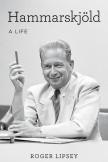A Uniter of Nations
Soon after U.N. Secretary General Dag Hammarskjöld died in a still-controversial plane crash in Africa in 1961, his friend Per Lin found a typewritten spiritual journal on the nightstand of Hammarskjöld’s New York City apartment. Attached to the manuscript was a note from Hammarskjöld addressed to another friend, Leif Belfrage, requesting him to determine whether this journal should be published.
Belfrage decided affirmatively and the result was the appearance in the United States in 1964 of one of the spiritual classics of the 20th century, Hammarskjöld’s Vägmärken, or Markings. In 1972 Hammarskjöld’s professional associate at the United Nations, Brian Urquhart, published a definitive account of the secretary general’s public life.
It is the goal of Roger Lipsey to reconcile these two earlier books, examining as much as evidence allows how the inner life influenced the actions of the outer man. The seeds of Hammarskjöld’s inner life were the clergymen and scholars in his maternal ancestry, while public service came naturally to the son of a Swedish prime minister.
Lipsey’s book will intrigue students of the Spiritual Exercises of St. Ignatius Loyola. Although Hammarskjöld was a Lutheran, his life paralleled Ignatius’ idea of a contemplative in action. He especially exemplified the exercise known as the “Call of the King.” Beneath an outward confidence in the force of the United Nations for good in the world was a deep sense of striving to serve Jesus Christ, a conviction that his international work was but a means to that end. Perhaps this spiritual detachment from his job was precisely what made Hammarskjöld an effective secretary general. Deeply familiar with medieval mystics like Meister Eckhart and Thomas à Kempis, Hammarskjöld was carrying a copy of the Imitation of Christ with him when he died.
Then there is the question of how Hammarskjöld died. Lipsey agrees with a British investigative journalist, Susan Williams, that the plane crash, which occurred during a mission to mediate civil war in the Congo, was an assassination rather than an accident. A combination of white supremacy, die-hard colonialism, cold war intrigue and corporate greed may have been responsible. If it is true that he was murdered, then Hammarskjöld’s striving to pattern himself after Christ was fulfilled even in the manner of his death. Lipsey strongly advocates a renewed official inquiry into the crash.
Hammarskjöld also read deeply in world religions, particularly Judaism and the spiritual writings of east and south Asia. He associated with the Jewish theologian Martin Buber. His mode was more that of a seeker than a confessor of God. However, Hammarskjöld usually found that what he valued the most about the various world religions was that they each endorsed the ethic of loving service to all humankind.
Lipsey does not neglect the outward record of Hammarskjöld’s tenure at the United Nations. In particular, he covers three major issues in detail: Hammarskjöld’s dealings with Communist China, his handling of the Suez Crisis of 1956 and the mediations in the Congo that led to his death. The great powers seem to have approved his nomination in the expectation that he was a colorless civil servant who would not challenge them. In each of these cases, they were proven wrong.
A sensitive dimension of the book is Lipsey’s exploration of Hammarskjöld’s sexuality. This was necessary because his vindictive predecessor as secretary general, Trygve Lie, operating in the vicious climate of international diplomacy during the McCarthy era, tried to discredit his successor-elect with American security forces by spreading rumors that Hammarskjöld was sexually active with other men. Ironically, in a changed climate years later this episode became a pretext for gay rights groups to celebrate Hammarskjöld as one of their own. Lipsey, however, concludes that the most important thing about Hammarskjöld’s sexuality was that he personally chose celibacy after the pattern of the medieval monks he so admired, and convincingly observes that this choice was far more important than the question of any specific object of Hammarskjöld’s desire. This chapter is a moving affirmation of voluntary celibacy, the more striking because it describes someone who never took a vow to live so.
Readers will also value the accounts of Hammarskjöld’s upbringing in the Swedish university town of Uppsala, where he was early exposed to Scandinavian philosophical and theological creativity, and his embrace of the cultural and artistic life of New York City as secretary general. This aspect of the book is a valuable reflection on the implications for U.N. officials of living in the cultural capital of the United States.
Lipsey’s account of the reception of Markings upon publication is one of his most interesting discussions. Well-respected immediately in the United States, it was highly controversial in the secular culture of Hammarskjöld’s native Sweden. The idea that a public official might have been a fervent Christian appalled many Swedish intellectuals, who denounced Hammarskjöld’s quest to become like Christ as narcissism. This reaction, which Hammarskjöld perhaps anticipated when he delegated the decision for or against publication to a friend, may explain the greatest mystery to emerge from Lipsey’s book. Why did Hammarskjöld not talk openly about his faith during his lifetime? It was this silence that made him least like the believer that Ignatius hoped would emerge from the Spiritual Exercises. Was it because he feared the opprobrium of his peers? This episode will provoke thought in an age that has become even more secular in the half century and more since Hammarskjöld died.
This article also appeared in print, under the headline “A Uniter of Nations,” in the August 12-19, 2013, issue.








